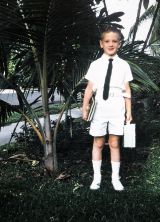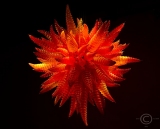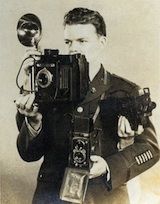A&S mode?
-
 Topic Author
Topic Author
- Fallin Star
- New Kid On The Block
-
- Sony a390
- Followers: 8
- Posts: 33
-
Points:
0
Post #72671
Post #72677
Really, it just doesn't matter. There is little difference between shooting in manual and shooting in other modes while adjusting the EC (exposure compensation). A shot taken at F8 & 1/125 with an ISO of 100 will be the same in any mode.
-

- KCook
- Photo Elder
-
- Canon EOS 50D and Olympus E-P5
- Followers: 1325
- Posts: 5410
-
Points:
32913
Post #72737
Kelly Cook
-

- DestinDave
- Photography Hooked
-
- Canon EOS 450D
- Followers: 38
- Posts: 907
-
Points:
0
Post #72755
While shooting a scene, if you are most concerned with motion (freezing action, soft waterfalls, etc), choose Tv (S), set a shutter speed to give you the correct action and let the camera choose the appropriate aperture for the shutter speed. You can adjust the exposure further with EV+/- as desired.
On the other hand, if you are more concerned with depth of field, choose the Av (A) setting which will give what you want and let the shutter speed vary accordingly.
All of the camera mode settings have merit and value for different situations. Many older folks who came up from the old manual-only film days may still swear by full-manual but that's strictly a personal choice. Great images are possible no matter how you set your camera - if you understand what the settings mean and what they are capable of.
Dave Speicher
I thought I wanted a career.. turns out I only wanted paychecks.
dlspeicher.zenfolio.com
-

- John Landolfi
- Super User
-
- Nikon D3S, D7100, Sony RX10, Canon G11, F4s, F2sb, RetinaflexIV etc, etc
- Followers: 1205
- Posts: 21605
-
Points:
40394
Post #72789
DestinDave wrote: The only "cheating" with using any of the auto modes is possibly cheating yourself out of a potentially better photograph. Full manual - M - may give you the most control over aperture and shutter settings but Av and Tv - (A & S) - still allow some control over these settings.
While shooting a scene, if you are most concerned with motion (freezing action, soft waterfalls, etc), choose Tv (S), set a shutter speed to give you the correct action and let the camera choose the appropriate aperture for the shutter speed. You can adjust the exposure further with EV+/- as desired.
On the other hand, if you are more concerned with depth of field, choose the Av (A) setting which will give what you want and let the shutter speed vary accordingly.
All of the camera mode settings have merit and value for different situations. Many older folks who came up from the old manual-only film days may still swear by full-manual but that's strictly a personal choice. Great images are possible no matter how you set your camera - if you understand what the settings mean and what they are capable of.
-

- Baydream
- Moderator
-
- Canoni/60D/70D/5DmkIII
- Followers: 388
- Posts: 11185
-
Points:
7278
Post #72799
KCook wrote: If you are shooting under controlled lighting, these modes will let the exposure vary from shot to shot, which may be undesirable. Since "manual" mode is really "fixed exposure" mode. As a happy snapper, not a studio guy, I use A and S much more often than M.
Kelly Cook
I took a workshop last year where the instructors INSISTED all shots should be made in Manual mode. y opinion after the class and trying their methods was that they must miss THOUSANDS of great shots because they are dickering around with their "mechanical devises". In certain "static" scenes, manual is OK (I learned it on an 8x10 camera) but A and S have gotten so good, use it.
Shoot, learn and share. It will make you a better photographer.
fineartamerica.com/profiles/john-g-schickler.html?tab=artwork
-
 Topic Author
Topic Author
- Fallin Star
- New Kid On The Block
-
- Sony a390
- Followers: 8
- Posts: 33
-
Points:
0
Post #72811
KCook wrote: If you are shooting under controlled lighting, these modes will let the exposure vary from shot to shot, which may be undesirable. Since "manual" mode is really "fixed exposure" mode. As a happy snapper, not a studio guy, I use A and S much more often than M.
Kelly Cook
How is manual mode a fixed exposure mode? Wouldn't Auto be a fixed exposure mode?
-
 Topic Author
Topic Author
- Fallin Star
- New Kid On The Block
-
- Sony a390
- Followers: 8
- Posts: 33
-
Points:
0
Post #72813
DestinDave wrote: The only "cheating" with using any of the auto modes is possibly cheating yourself out of a potentially better photograph. Full manual - M - may give you the most control over aperture and shutter settings but Av and Tv - (A & S) - still allow some control over these settings.
While shooting a scene, if you are most concerned with motion (freezing action, soft waterfalls, etc), choose Tv (S), set a shutter speed to give you the correct action and let the camera choose the appropriate aperture for the shutter speed. You can adjust the exposure further with EV+/- as desired.
On the other hand, if you are more concerned with depth of field, choose the Av (A) setting which will give what you want and let the shutter speed vary accordingly.
All of the camera mode settings have merit and value for different situations. Many older folks who came up from the old manual-only film days may still swear by full-manual but that's strictly a personal choice. Great images are possible no matter how you set your camera - if you understand what the settings mean and what they are capable of.
Wow, thank you for all that information. I wasn't expecting such an indepth answer. Thanks
-

- KCook
- Photo Elder
-
- Canon EOS 50D and Olympus E-P5
- Followers: 1325
- Posts: 5410
-
Points:
32913
Post #72941
Fallin Star wrote:
KCook wrote: If you are shooting under controlled lighting, these modes will let the exposure vary from shot to shot, which may be undesirable. Since "manual" mode is really "fixed exposure" mode. As a happy snapper, not a studio guy, I use A and S much more often than M.
Kelly Cook
How is manual mode a fixed exposure mode? Wouldn't Auto be a fixed exposure mode?
By "fixed", I meant that the exposure settings remain "stuck" on the last values. No matter how many shots you take, same settings. Until you adjust a setting yourself. At least until you change the camera battery. Assuming also in a fixed ISO setting, not Auto ISO.
Unless you have enabled AE Lock, the A or S mode will re-meter the scene, and adjust the exposure settings, each time you take another shot. So as long as anything in the scene is changing, there is a good chance an exposure setting will change as well.
Kelly
-

- Henry Peach
- Apprentice
-
- I currently use a 5DII or Sony Nex-3 most of the time.
- Followers: 50
- Posts: 2925
-
Points:
16
Post #73119
Fallin Star wrote: Also is there any downside with using these modes?
Yes. They will vary the exposure based on scene tonality. Even if the lighting does not change when the meter is pointed at a darker object it will tend to over-expose, and when pointed at a lighter object it will tend to under-expose. Unless exposure compensation is adjusted for each situation. They work great when scene tonality is fairly uniform.
-

- MLKstudios
- Banned
-
- D800 ;-)
- Followers: 72
- Posts: 4480
-
Points:
2
Post #73197
Matthew
PS once an exposure is set, you needn't change it for EVERY shot. Only change it when the light changes.
Matthew L Kees
MLK Studios Photography School
www.MLKstudios.com
[email protected]
"Every artist, was once an amateur"
-

- Screamin Scott
- Moderator
-
- Nikon D610, Nikon D7100, Nikon D300, Olympus OMD E-M5 MarkII, Olympus OM-D E-M10, Olympus Pen E-P3 + film SLR's
- Followers: 1384
- Posts: 6855
-
Points:
39981
Post #73277
MLKstudios wrote: As Henry (do you prefer Henry or Matt?) pointed out, there are times it makes things worse. Manual will give you a uniform exposure, until you manually change it. Like which format should you use, it depends on many factors, including what you have to work with.
Matthew
PS once an exposure is set, you needn't change it for EVERY shot. Only change it when the light changes.
Of course, there are times even when the light changes, that you may still not want to change your settings (low key/high key for instance) due to wanting a certain effect. Remember that the meter is only a dumb tool & can be fooled. Knowing how your metering mode is reading a scene will allow you to have more control over the outcome...I still know of a good number of photographers who spot meter on the brightest/darkest elements of a scene to determine what settings they want to use...(the Zone system, as I'm sure some of you are already familiar with)
-

- MLKstudios
- Banned
-
- D800 ;-)
- Followers: 72
- Posts: 4480
-
Points:
2
Post #73283
Matthew
Matthew L Kees
MLK Studios Photography School
www.MLKstudios.com
[email protected]
"Every artist, was once an amateur"
-

- Screamin Scott
- Moderator
-
- Nikon D610, Nikon D7100, Nikon D300, Olympus OMD E-M5 MarkII, Olympus OM-D E-M10, Olympus Pen E-P3 + film SLR's
- Followers: 1384
- Posts: 6855
-
Points:
39981
Post #73285
Latest Reviews
The Canon EOS R100 is an entry-level mirrorless camera introduced in 2023. But just because it’s an entry-level camera doesn’t mean it’s a bare-bones camera. Find out why in this review!
Nikon’s retro-looking Nikon Zfc is anything but retro. Under its classic body is a host of features and amenities that make it a worthwhile compact mirrorless camera for 2024.
The Canon EOS R50 is one of the newest R-system cameras from Canon. Is it worth your money? Find out all the details you need to know in this comprehensive review.
The Sony FE 70-200mm f/2.8 GM OSS II is Sony’s flagship mirrorless zoom lens. As such, it’s loaded with features and has a top-shelf build quality that makes it a top pick!
Latest Articles
Using leading lines in photography helps improve the composition by drawing viewers in and leading their eye from the foreground to the background. Explore some fine examples of this in this guide!
The Insta360 has one of the best lineups of action cams and 360-degree cameras. With these Insta360 accessories, you can elevate your photography and videography game!
Creating impactful photos of landscapes depends on many factors, not the least of which is your talent behind the lens. This guide explores other elements required for the best product.
The Canon EOS R100 is an entry-level mirrorless camera introduced in 2023. But just because it’s an entry-level camera doesn’t mean it’s a bare-bones camera. Find out why in this review!
Are you ready to upgrade your camera? Before buying new, you might consider the value of purchasing used gear to save money.
The Olympus OM-D E-M10 Mark IV is a micro four thirds camera released in 2020. It’s an entry-level system along with the OM-D E-M5 Mark III. Use this guide to determine which one is best for you!
Blue hour photography might not be as well known as golden hour photography, but it is every bit as good a time to create epic images of landscapes. Learn how in this quick tutorial!
Nikon’s retro-looking Nikon Zfc is anything but retro. Under its classic body is a host of features and amenities that make it a worthwhile compact mirrorless camera for 2024.















